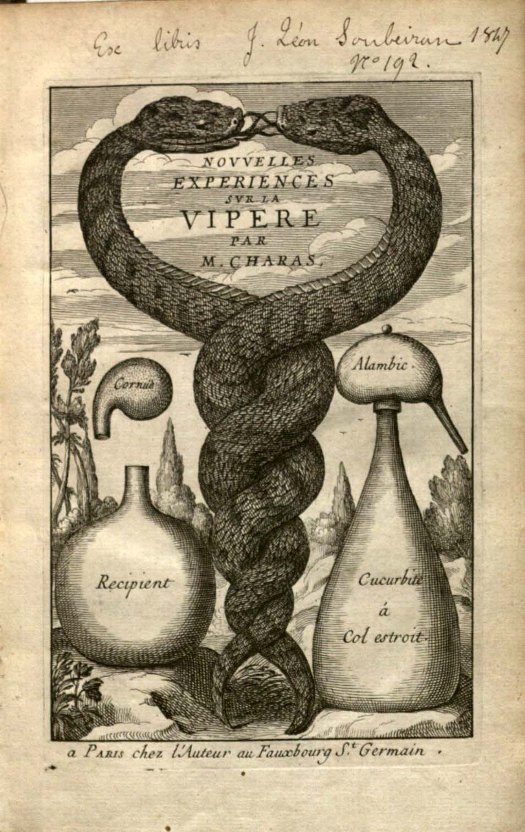Viper Militia
In his book on the viper, Nouvelles experiences sur la vipere, Parisian apothecary Moyse (or Moïse) Charas takes to task Italian physician, naturalist, and poet Francesco Redi (1626-1697), for his scientific study of viper bites, the first such research ever. Charas was of the opinion (and not alone in it) that venom per se was harmless and that death was caused by poisonous spirits injected into the victim by the mind of an infuriated viper. Charas’s title-page shows two vipers entwined as in the caduceus, or staff of Mercury, one of the symbols of the medical profession. The Aesculapian staff, after the Greco-Roman God of medicine and healing, Aesculapius, is branched at the top with a single snake twined around it; it is the official insignia of the American Medical Association.
Charas, Moyse (1618-1698). Nouvelles experiences sur la vipere.
A Paris: chez l’auteur et Olivier de Varennes, 1669. Ellis Omnia B30.
Click image to enlarge.
Charas recommended viper as a staple of the diet and as a preventive and cure for a good many diseases. His 17th century compatriot and contemporary Pierre Pomet (1658-1699) recommended distilled salts of viper to prevent measles, smallpox, plague, and scurvy, and to cure gout, rheumatisum, and venereal disease. Viper heart was prescribed for mealcholia. In another book, Trakat über den Theriak, Charas extols theriac, an anti-leprosy medicine made from powdered snake and used since antiquity; in medieval Europe the powder was formed into tablets, stamped with a snake image, and used against the bubonic plague. But that ain’t nothin’; our American frontiersmen gladly bought greasy-kid-stuff from snake-oil salesmen who took their money and swore the oil would grow hair back on their heads and cure the goiter to boot.
On the added engraved title-page of the Spencer Library’s copy (pictured above) is the inscription of the book’s former owner, French pharmacist and botanist Jean Leon Soubeiran (1827-1892). Soubeiran was the author of books on materia medica from all the kingdoms of nature–plant, animal, and mineral–including one on the venom of poisonous snakes.
Sally Haines
Rare Books Cataloger
Adapted from her Spencer Research Library exhibit and catalog, Slithy Toves: Illustrated Classic Herpetological Books at the University of Kansas in Pictures and Conservations.
Tags: history of science, Jean Leon Soubeiran, Moyse Charas, natural history, Nouvelles experiences sur la vipere, Sally Haines, snakes, Vipers

